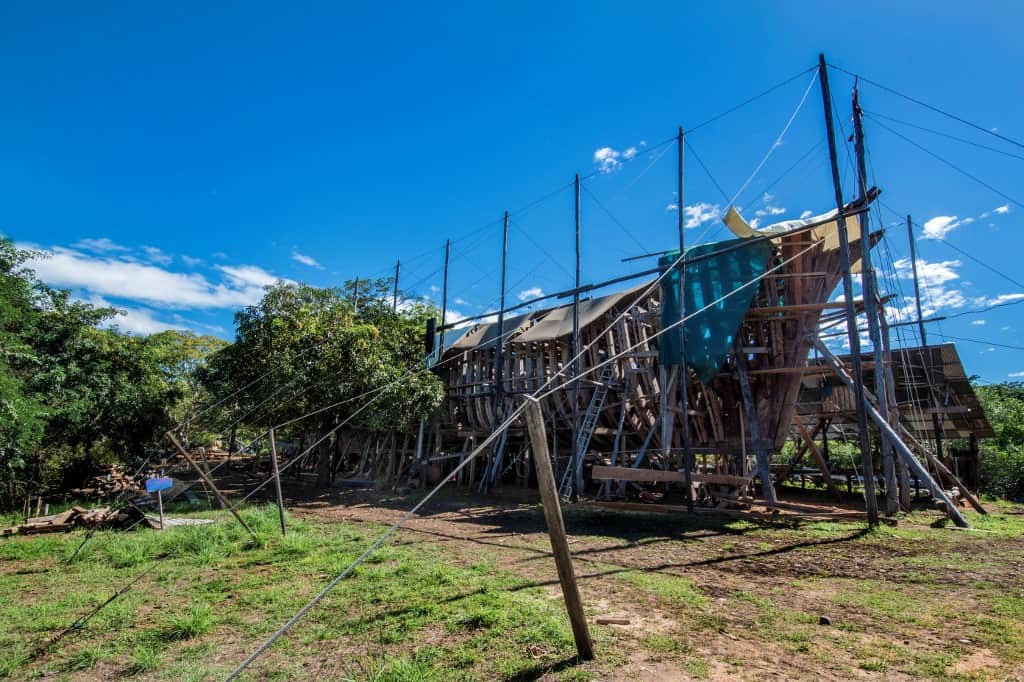On the shore of a mangrove in the Central Pacific of Costa Rica, a huge sailboat is beginning to take shape. But it’s not just any vessel. It will carry cargo with the force of the wind, and without fossil fuels.
When its construction is complete, it will be 45 meters long and will be able to transport 350 tons of cargo, equivalent to nine containers. It will be called Ceiba, like the sacred tree of the Mayans, the tree of life.
The shipyard in the small coastal town of Punta Morales is a Tower of Babel where French, Germans, Belgians, Poles, and Costa Ricans sand wood, shape the ship’s “ribs” and screw the pieces of the future boat into place.
One of the workers is Misael Ledesma, a fisherman from the neighboring community of Costa de Pájaros. “This boat is going to be under sail, without motor, without pollution. It goes back 300 years,” he says.
Behind the project is Lynx Guimond, a French-Canadian adventurer, cabinetmaker, sailor and artist who founded the company Sailcargo, responsible for the wooden boat, together with his wife Danielle Doggett and Costa Rican partner John Porras.
Ceiba is the first boat developed by Sailcargo, valued at $4.2 million and financed by private investors.
Emission-free transport
“It is going to be a sailboat with three masts that are large enough to transport goods,” Guimond told AFP inside the under-construction ship.
“This is going to be the largest cargo sailboat in the world when it is working. It will have auxiliary electric motors, but its main form of propulsion will be the sails. It will be emission-free,” he says.
Guimond says the company began seeking financing on the Kickstarter platform, with contributions of $100 or more, although with the advanced project, the minimum investment is $10,000. He already has about half the resources needed.
Sailcargo will be the manager of the ship, which will offer cargo transportation services for goods such as coffee, cocoa and other goods.
In the center of the sailboat will be the cargo area, while in the rear will be the captain’s cabin and the lithium motors, which will be powered by wind generators.
In the front part will be located the crew dormitories with capacity to accommodate 24 people, among which they hope to include investors, academics and university students who want to participate.
By not depending on fuels, the only limitation to navigate will be drinking water. The ship’s warehouses allow Ceiba to be at sea for up to 45 days in a row.
Efficient and profitable
Data from the International Maritime Organization (IMO), in a 2014 report, revealed that maritime transport was responsible for the emission of one thousand metric tons of carbon dioxide (CO2) per year between 2007 and 2014, about 3.1% of the world total.
According to the organization Transport & Environment, which promotes the reduction of emissions in transport, the sector could become responsible for 10% of global CO2 emissions if it does not take measures to reduce them.
Sailcargo wants to prove that it is possible to make efficient, profitable and emission-free freight transport.
The project started from scratch. Guimond and his team had to train local residents and workers who came from abroad to participate in the initiative, even having to develop part of the required tools, according to Guimond.
Other workers arrived from Europe, attracted by the news of the cargo megasailer.
One of them is Arturo, a young Polish landscaper who works shirtless in the heat of Punta Morales.
“This project is talked about a lot in shipyards in Europe,” he explains. That talk attracted several to Punta Morales.
Guimond, who trained as a cabinetmaker, arrived many years earlier in Costa Rica, where he settled to sculpt figureheads that he sent to shipyards in Europe.
All of this after traveling the world as a boater and working as a shipbuilder in shipyards in the Netherlands.
“I was attracted to the culture, the atmosphere, I just felt good here,” he recalls. “Here he made the sculptures and sent them to the shipyards” in Europe and the Caribbean.
“For the Ceiba, I already have a beautiful sculpture in mind. It is always good to have a female face that represents the soul of the ship, but also many animals and flora. Something that represents Costa Rica.”






